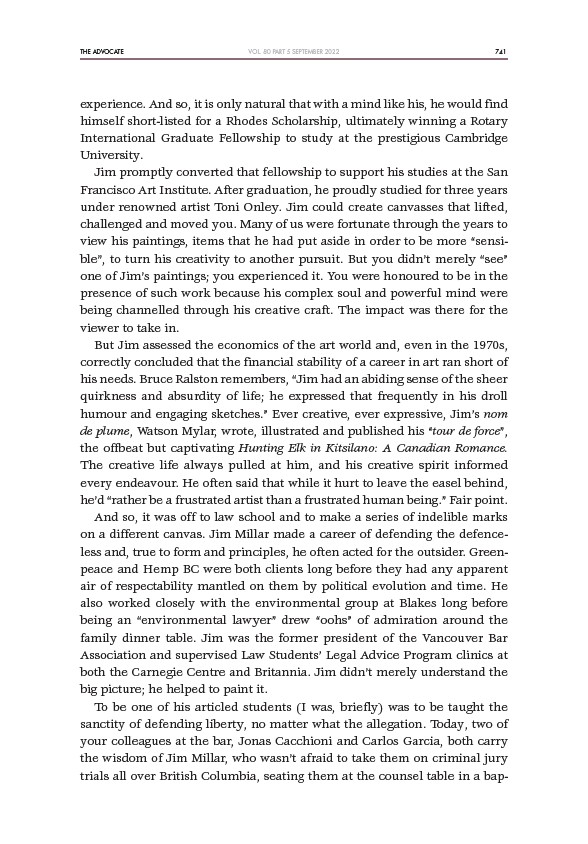
THE ADVOCATE 741
VOL. 80 PART 5 SEPTEMBER 2022
experience. And so, it is only natural that with a mind like his, he would find
himself short-listed for a Rhodes Scholarship, ultimately winning a Rotary
International Graduate Fellowship to study at the prestigious Cambridge
University.
Jim promptly converted that fellowship to support his studies at the San
Francisco Art Institute. After graduation, he proudly studied for three years
under renowned artist Toni Onley. Jim could create canvasses that lifted,
challenged and moved you. Many of us were fortunate through the years to
view his paintings, items that he had put aside in order to be more “sensible”,
to turn his creativity to another pursuit. But you didn’t merely “see”
one of Jim’s paintings; you experienced it. You were honoured to be in the
presence of such work because his complex soul and powerful mind were
being channelled through his creative craft. The impact was there for the
viewer to take in.
But Jim assessed the economics of the art world and, even in the 1970s,
correctly concluded that the financial stability of a career in art ran short of
his needs. Bruce Ralston remembers, “Jim had an abiding sense of the sheer
quirkness and absurdity of life; he expressed that frequently in his droll
humour and engaging sketches.” Ever creative, ever expressive, Jim’s nom
de plume, Watson Mylar, wrote, illustrated and published his “tour de force”,
the offbeat but captivating Hunting Elk in Kitsilano: A Canadian Romance.
The creative life always pulled at him, and his creative spirit informed
every endeavour. He often said that while it hurt to leave the easel behind,
he’d “rather be a frustrated artist than a frustrated human being.” Fair point.
And so, it was off to law school and to make a series of indelible marks
on a different canvas. Jim Millar made a career of defending the defenceless
and, true to form and principles, he often acted for the outsider. Greenpeace
and Hemp BC were both clients long before they had any apparent
air of respectability mantled on them by political evolution and time. He
also worked closely with the environmental group at Blakes long before
being an “environmental lawyer” drew “oohs” of admiration around the
family dinner table. Jim was the former president of the Vancouver Bar
Association and supervised Law Students’ Legal Advice Program clinics at
both the Carnegie Centre and Britannia. Jim didn’t merely understand the
big picture; he helped to paint it.
To be one of his articled students (I was, briefly) was to be taught the
sanctity of defending liberty, no matter what the allegation. Today, two of
your colleagues at the bar, Jonas Cacchioni and Carlos Garcia, both carry
the wisdom of Jim Millar, who wasn’t afraid to take them on criminal jury
trials all over British Columbia, seating them at the counsel table in a bap-